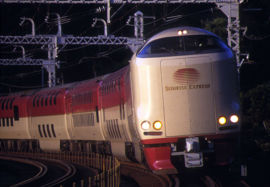Sunrise Izumo/Sunrise Seto

The Sunrise Izumo (サンライズ出雲 Sanraizu-Izumo?) and Sunrise Seto (サンライズ瀬戸 Sanraizu-Seto?) are two overnight train services that connect Tokyo and cities in the western part of Japan. They are operated by Japan Railways.
Sunrise Izumo runs daily between Tokyo and Izumo in Shimane Prefecture. Sunrise Seto runs daily between Tokyo and Takamatsu in Kagawa Prefecture (and extends to Matsuyama in Ehime Prefecture during peak periods) on the island of Shikoku.
Sunrise Izumo and Sunrise Seto run in tandem between Tokyo Station and Okayama. From Tokyo, the combined 14-car train stops at Yokohama, Atami, Numazu, Fuji, Shizuoka, Hamamatsu (final evening stop), Himeji (first morning stop), Kamigori and Okayama before splitting into their respective segments.
On the return trip from Okayama to Tokyo, the combined train stops at Himeji, Sannomiya, Osaka (final evening stop), Shizuoka (first morning stop), Fuji, Numazu, Atami and Yokohama before arriving in Tokyo.
Between Okayama and Izumoshi, the 7-car Sunrise Izumo train stops at Kurashiki, Niimi, Yonago, Yasugi, Matsue and Shinji.
Between Okayama and Takamatsu, the 7-car Sunrise Seto train stops at Kojima and Sakaide.
The Sunrise Izumo and Sunrise Seto consist of type "A" and type "B" accommodations. A flat fee is charged for all rooms, regardless of starting or ending location. Currently, accommodation rates range from about ¥6,300 for a type "B" compartment or solo room to ¥13,300 for a type "A" Single Deluxe room (for one person) and ¥14,700 for a type "B" twin room (for two people).
The other fares, the basic fare and limited express fare, are based on distance. For foreign tourists using the Japan Rail Pass, the basic fare does not have to be paid.
A shower is located in one carriage of each of the two segments, and can be used for ¥310 (a towel kit costs an additional ¥200). Passengers who stay in the type "A" Single Deluxe rooms can use the dedicated showers in their carriage for free.
History
Before Sunrise Seto and Sunrise Izumo were introduced in 1998, Seto and Izumo operated as separate overnight limited express services connecting passengers from Tokyo to Shikoku and the Sanin Region, respectively.
However, these trains were becoming less popular as equipment became outdated, and air and bus transportations attracted more passengers. Sunrise Seto and Izumo were intended to attract more passengers to train transportation by introducing newly designed trains and by reducing the time to travel.
With the introduction of Sunrise Seto/Sunrise Izumo, the older Seto service was discontinued but the older Izumo remained as a separate service until 2006; it served the Sanin Main Line between Kyoto and Tottori Prefecture, most of which was not electrified and thus inaccessible by the electric Sunrise trains. But Izumo was discontinued on March 13, 2006 due to continuing decline in ridership, leaving Sunrise Izumo as the only overnight train service between the Sanin Region and Tokyo.
Sunrise trains have an advantage over airline in that it arrives in destination cities in the morning before the first airline flights, and do not require travel between the airport and city centers Sunrise trains are also used by passengers who missed the Shinkansen super express that runs along with Sunrise Izumo between Okayama and Tokyo but ceases operation at night.
Route
The Sunrise Izumo and Sunrise Seto run over the following routes, operated by the following companies:
Surise Izumo/Sunrise Seto combined train (Tokyo - Okayama)
- Tōkaidō Main Line, Atami - Maibara
- Tōkaidō Main Line, Maibara - Kobe
- Sanyō Main Line, Kobe - Okayama
Sunrise Izumo segment (Okayama - Izumoshi)
JR West
- Sanyō Main Line, Okayama - Kurashiki
- Hakubi Line, Kurashiki - Hōki-Daisen
- Sanin Main Line, Hōki-Daisen - Izumo-Shi
Sunrise Seto segment (Okayama - Takamatsu)
JR West
- Seto-Ohashi Line, Okayama - Kojima
- Seto-Ohashi Line, Kojima - Utazu
- Yosan Line, Utazu - Takamatsu
- Yosan Line, Takamatsu - Matsuyama (Peak seasons only)
